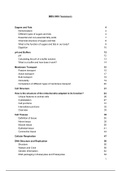Study guide
BBS1001 LEGO Bricks of Life Full Summary
- Course
- Institution
- Book
Hey guys, I'm uploading my full summary of BBS1001 LEGO Bricks of Life. The study guide has a neat table of contents and all tutorials (with added lecture notes). I go through every topic needed for the exam in helpful bullet points with lots of pictures.
[Show more]




